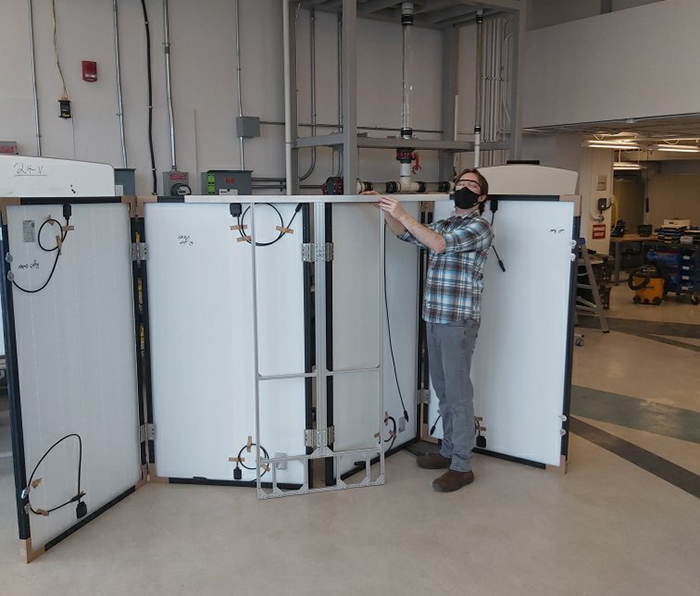Jacob Maxwell, a 2008 graduate of Gulf Islands Secondary School (GISS), has led a team of Alberta engineering technologists in the design of an award-winning off-grid wireless internet system for remote communities.
The student team worked on the design last year and in December it was named Capstone of the Year by the Association of Science and Engineering Technology Professionals of Alberta (ASET). The design combines SpaceX internet technology with solar power to provide affordable wireless internet to remote and off-grid communities, a concept which will be tested in Canada by a charity sponsoring the project.
Maxwell said he experienced the development of internet technology firsthand growing up on Salt Spring. From his first 56K dial-up modem in Grade 7, to DSL and then broadband internet when he went to university in Vancouver, the issue of improving internet access is a personal one for him.
“I was really lucky to work on this capstone project where we identified this need, this lack of accessibility for many places in the world that are still going through that same transition that Salt Spring experienced when I was growing up,” he said.
As an alternative energy technology student at the Northern Alberta Institute of Technology (NAIT), Maxwell worked alongside former classmates Natasha Bergstrom-Baier and Abdallah Farah and former wireless systems engineering technology students Steven Sager and Spencer Tracy.
The team first looked at a system for a single household, which wasn’t feasible with their aim of keeping it affordable. They then began looking at a distributed approach using the broadband system being developed by Elon Musk’s company SpaceX.
The team tackled what many students had tried to do before, said ASET’s CEO Barry Cavanaugh, yet there was always something they couldn’t master. With the use of SpaceX’s Starlink system, the missing link was found.
“And using solar power to power it makes it really attractive . . . they can afford to do it that way in all kinds of remote communities,” Cavanaugh said, adding that it lines up with the Government of Canada’s stated aim to supply rural and remote communities with high speed internet.
The Starlink user terminal is attached to a wireless internet service provider device, which could be run by a local business or by the community who would pay the subscription fee to Starlink.
Beta testing showed a single Starlink unit could provide 70 to 120 megabits per second, which is “fantastic, that’s broadband speed,” Maxwell said. The team found the unit can provide wireless internet in a 600-metre diameter under ideal conditions, a 300-metre radius providing up to 100 users within that range internet at a speed of around one megabit per second.
To power the off-grid system, the team designed solar modules with battery energy storage.
“Even though it’s basic internet service by our standards, it’s still a tremendous improvement for people who are off grid and never had internet before,” Maxwell said.
So many benefits stem from being able to access the internet, he added, from entertainment, social connection, income potential, and access to education and health care.
Internet can be extremely expensive for remote communities because of the infrastructure needed, including landlines, fibre optic and transmission cables, as well as the cost of maintenance. In comparison, the cost of this system is between $7,000 to $10,000 before installation costs.
Costs could vary depending on how much sunlight the community gets. The energy consumption of the whole system is around 120 watts, which is not a lot of solar, Maxwell said, but more than that needs to be stored for use overnight or in cloudy conditions.
“The cost of the solar and battery components are directly proportional to . . . the longest night of the year,” he explained.
The concept is feasible around the Edmonton latitude of Canada, yet pushing further north towards the Arctic circle means they’d need to look at hybridizing the system with other renewable sources like wind or biomass.
It could work in places like Salt Spring, or anywhere it’s too expensive to build out a utility grid, because Starlink is a global service.
The team completed the project a year ago when it wasn’t possible to test the Starlink terminal in Edmonton, so a lot of their work was done as a computational assessment of what would be possible. The project sponsor is planning to test the concept in Canada before they consider integrating the team’s findings into their global charity operations. For the time being, Maxwell said, he couldn’t specify the name of the charity or more about their plans.
The team is interested in sharing their research with non-profits or governments who are interested in similar projects with a humanitarian mandate.
“This should be something that enables people to connect to the wider world and educate themselves and improve their standard of living,” he said. “It shouldn’t be a means to an end to extract currency from a location.”
“It was something that I picked up by osmosis just from living on Salt Spring for as long as I did and seeing all the community efforts there that appreciate and preserve and conserve nature,” Maxwell said of his career path so far.
Maxwell is currently in his last months of training as a wind turbine technician and electrician at Lethbridge College. He aims to take his knowledge and work on offshore wind installations in remote regions.
“Energy independence is an important thing for isolated locations,” he said, adding he’d like to work on hybridized systems which combine wind with solar power to install resilient power grids. He was inspired to go in this direction after visiting Cuba and seeing the island powered by diesel stations.
In the future “once my body is worn down and things don’t bend like they used to after time in the field,” Maxwell said he’d like to return to GISS to teach renewable energy technologies if such a position exists then.


